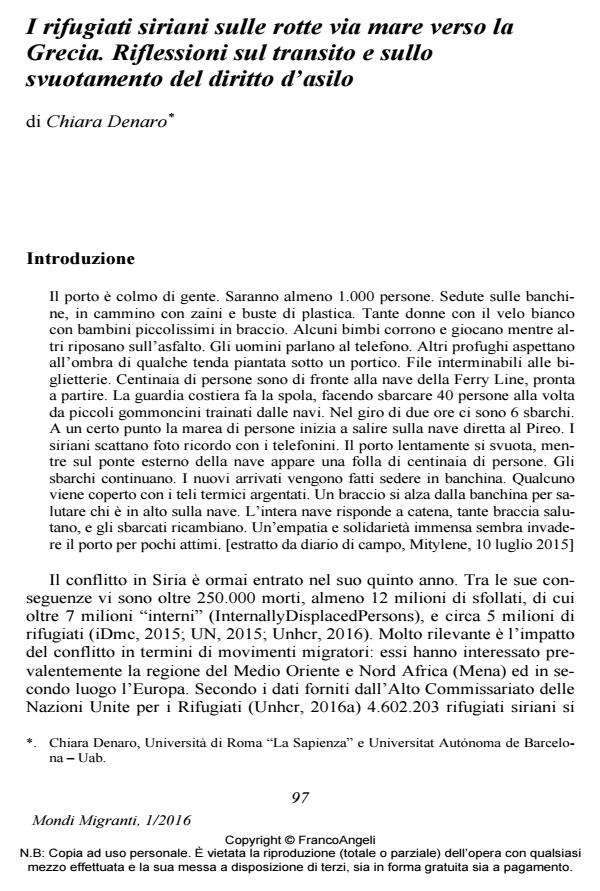I rifugiati siriani sulle rotte via mare verso la Grecia. Riflessioni sul transito e sullo svuotamento del diritto d’asilo
Titolo Rivista MONDI MIGRANTI
Autori/Curatori Chiara Denaro
Anno di pubblicazione 2016 Fascicolo 2016/1
Lingua Italiano Numero pagine 23 P. 97-119 Dimensione file 96 KB
DOI 10.3280/MM2016-001006
Il DOI è il codice a barre della proprietà intellettuale: per saperne di più
clicca qui
Qui sotto puoi vedere in anteprima la prima pagina di questo articolo.
Se questo articolo ti interessa, lo puoi acquistare (e scaricare in formato pdf) seguendo le facili indicazioni per acquistare il download credit. Acquista Download Credits per scaricare questo Articolo in formato PDF

FrancoAngeli è membro della Publishers International Linking Association, Inc (PILA)associazione indipendente e non profit per facilitare (attraverso i servizi tecnologici implementati da CrossRef.org) l’accesso degli studiosi ai contenuti digitali nelle pubblicazioni professionali e scientifiche
Nel quadro dell’evoluzione delle rotte migratorie via mare, avvenuta a cavallo tra 2011 e 2015 nello spazio Mediterraneo e della nuova centralità del corridoio orientale, il presente articolo si focalizza sul confine Greco-Turco inteso quale meccanismo di ‘inclusione differenziale’ (Mezzadra e Neilson, 2013). La configurazione della Grecia quale luogo di transito nella cosiddetta ‘rotta balcanica’, che prevede l’attraversamento di Macedonia, Serbia e Ungheria, e Austria al fine di raggiungere la Germania o di proseguire verso la Svezia viene letta alla luce della sua manifesta inadeguatezza come ‘paese di asilo’, già constatata dalla Corte Europea dei Diritti dell’Uomo nel 2011 e nel 2014. Nel presente articolo, a partire dall’interpretazione del diritto di asilo quale ‘porta d’accesso’ ad altri diritti civili, politici e sociali e dalla constatazione del suo progressivo "svuotamento" (Sciurba, 2014), si analizza il suo contenuto in alcuni luoghi di frontiera. Esso viene concettualizzato in termini di accesso al territorio, accesso alla procedura e allo status, accesso alla prima accoglienza. L’articolo si conclude con una riflessione sul transito dei rifugiati siriani attraverso l’Europa, che prende forma attraverso percorsi di empowerment e di resistenza, e appare fortemente legato al processo di svuotamento del diritto di asilo.
Parole chiave:Asilo politico, Grecia, rotte migratorie, transito, agency, rifugiati siriani.
- Bibliographie sélective in Migrations Société /2018 pp.103
DOI: 10.3917/migra.174.0103 - Bibliographie sélective in Migrations Société /2023 pp.121
DOI: 10.3917/migra.191.0121
Chiara Denaro, I rifugiati siriani sulle rotte via mare verso la Grecia. Riflessioni sul transito e sullo svuotamento del diritto d’asilo in "MONDI MIGRANTI" 1/2016, pp 97-119, DOI: 10.3280/MM2016-001006